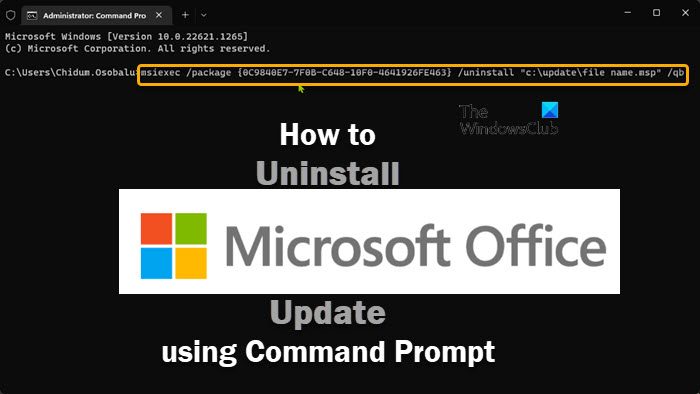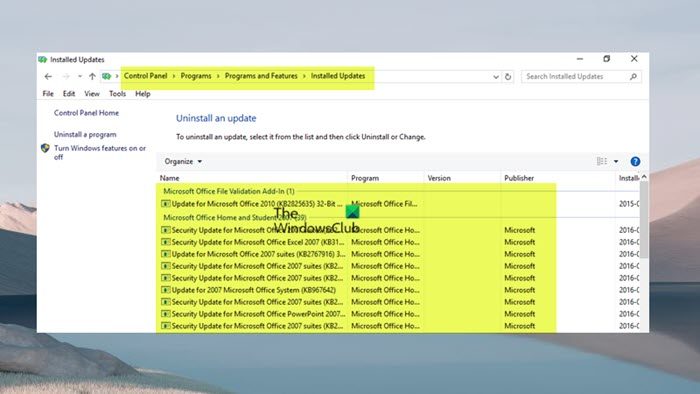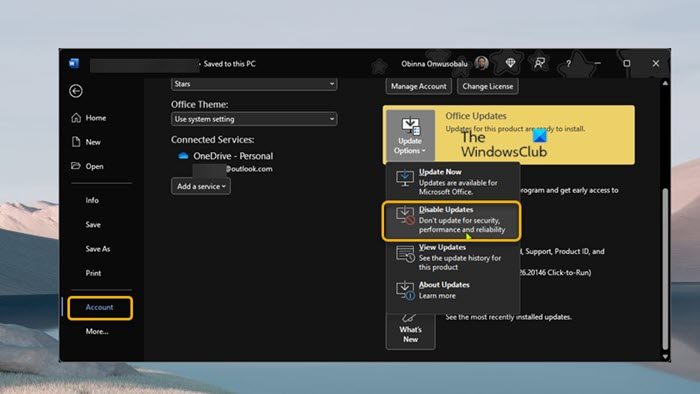Windows users can uninstall an Office update via the Programs and Features applet in Control Panel. But for one reason or another, you may not be able to use this applet for the task. In this post, we outline the specifics of why this is the case, and then show you how to uninstall Office Updates using the command line in Windows 11/10 in such cases.

Uninstall Office update using the command line in Windows 11/10
If a particular update breaks functionality in Microsoft Office installed on your Windows 11/10 computer, you can open the Control Panel and uninstall the Office update via the Programs and Features applet. However, there are requirements to remove Office updates, and you need to determine whether an Office update can be removed using the Control Panel. That said, the following are some examples of Office Updates that can’t be removed:
- Service packs
- Office Server product updates
- Some updates to Office shared components.
Although not recommended or supported by Microsoft, you can uninstall Office updates that are marked as ‘Uninstallable’ by creating the Uninstallable registry key with the dword:00000001 value at the following location:
HKEY_LOCAL_MACHINE\SOFTWARE\Microsoft\Windows\CurrentVersion\Installer\UserData\S-1-5-18\Products\Office GUID\Patches\Compressed GUID
Read: How to uninstall Windows Updates marked as Permanent without Uninstall option
To use the Control Panel to remove Office updates, the computer running Microsoft Office must meet the following prerequisites:
- Microsoft Windows Installer version 3.1 or later must be installed before you install the removable Office update.
- The computer must be running newer versions of the Windows OS.
To determine whether you can remove an Office update via the Programs and Features applet, follow these steps:

- Press the Windows key + R key to invoke the Run dialog.
- In the Run dialog box, type appwiz.cpl and hit Enter.
- On the left navigation pane, click the View installed updates link.
- Locate and select the update in the list.
- If the update can be removed, the Uninstall option will be available in the toolbar or on the context menu if you right-click the listed update.
Read: How to uninstall Programs not listed in Control Panel
If you can’t uninstall an Office update using the wizard, then you can do so via the Windows Installer command line. For example, to remove an update, run the command below:
msiexec /package {product_code} /uninstall "full_path_to_.msp_file" /qb
Where:
- The product_code placeholder represents the product code GUID that is associated with the Office product that you installed an update on.
- The full_path_to_.msp_file placeholder represents the full path of the update package (.msp file).
- If you use the
/qbswitch, you’re prompted if an update isn’t removable with the message below.
Uninstallation of the patch package is not supported.
- If you use the
/passiveswitch, you aren’t prompted if an update isn’t removable.
Alternatively, the command below can be used to uninstall Office updates.
%windir%\System32\msiexec.exe /package {Office GUID} /uninstall {Update GUID} /QN
For the command syntax, you must determine the GUID of the installed Office version and the GUID of the update as detailed in this Microsoft documentation.
Now, the Office updates you will see listed in Programs and Features > View installed updates window as shown above on your Windows 11/10 PC will be the MSI-based installations of Office.
How to revert to a previous build number of Microsoft 365
Microsoft 365 installations use a different update mechanism called Click-To-Run installations which are essential “always up to date” via the cloud and not via Windows Update. All Office 2021/19 and later editions and non-volume license installations of Office 2016 and later use the same Click-To-Run technology as Office as part of a Microsoft 365 subscription.
In this case, you cannot uninstall or remove the Office update for these versions of Office installation. However, you can revert to a previous build number (from before the update) of Microsoft 365. To do this, follow these steps:

- First, disable Office Updates as the Microsoft 365 installations are automatically updated in the background.
- Open any Office app and navigate to File > More > Account > Update Options > Disable Updates.
- Next, open Command Prompt in admin mode.
- Next, depending on your Office version, run the command below that applies:
Office 2021, 2016, Office 2019, Office 2021, Microsoft 365 and later
cd %programfiles%\Common Files\Microsoft Shared\ClickToRun\
Office 2013 on Windows 32-bit
cd %programfiles%\Microsoft Office 15\ClientX86\
Office 2013 on Windows 64-bit
cd %programfiles%\Microsoft Office 15\ClientX64\
- Now, run the command below to revert to the Office build you want. There is an overview of build numbers you can return to for Office 2013 | Office 2016 and Office 2019 | Office 2021 | Microsoft 365.
officec2rclient.exe /update user updatetoversion=BuildNumber
- Once the command executes, the Checking for updates dialog will open shortly followed by the Downloading Office updates dialog. Once this dialog closes, the rollback has been completed and the Updates were installed dialog will now be displayed.
- Click Close to exit.
Now that you’ve disabled automatic Office updates, make sure to re-enable the updates as soon as possible to ensure you don’t miss out on newly released security updates, feature fixes, or new features.
I hope you find this post informative.
Read: How to roll back Microsoft Office to the previous version
What is WUSA in CMD?
WUSA.exe is a native utility that is used to install standalone updates on Windows computers. Standalone updates are the kind of updates that are not available in Windows Update by default. It also can be used to install some problematic updates. To run this utility on your Windows 11/10 PC, simply open the command prompt, then type wusa.exe followed by the syntax for the action you want to perform, and hit Enter.
Read: An error has occurred, Not all of the updates were successfully uninstalled
How do I uninstall Office updates on Windows 11?
To uninstall Office updates on Windows 11/10 depends on if you have installed the MSI or Click-To-Run (C2R) version of Office. In any case, we have provided relevant information as well as step-by-step instructions on how you can efficiently perform either task in this post above. If you’re having Office update problems like the stuck at Updating Office, please wait a moment, you can try restarting your computer and see if that helps.
Read: Office Click-to-Run Extensibility Component Error, Can’t Install Office.